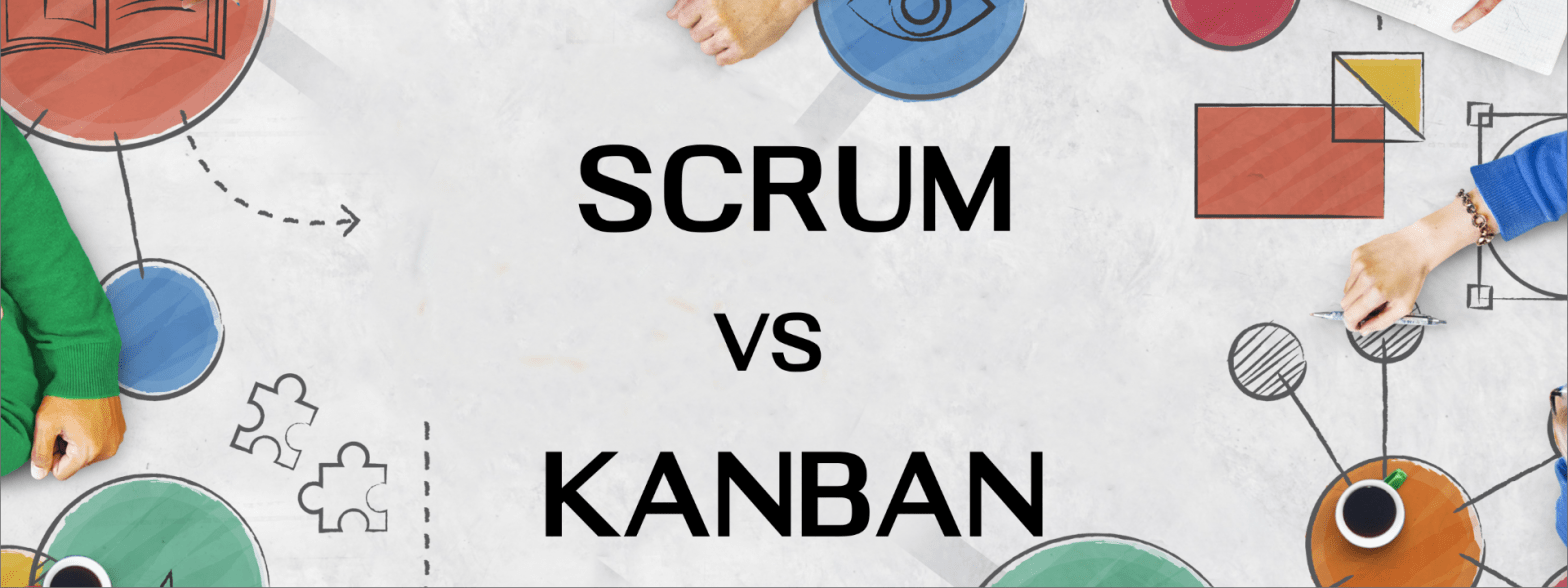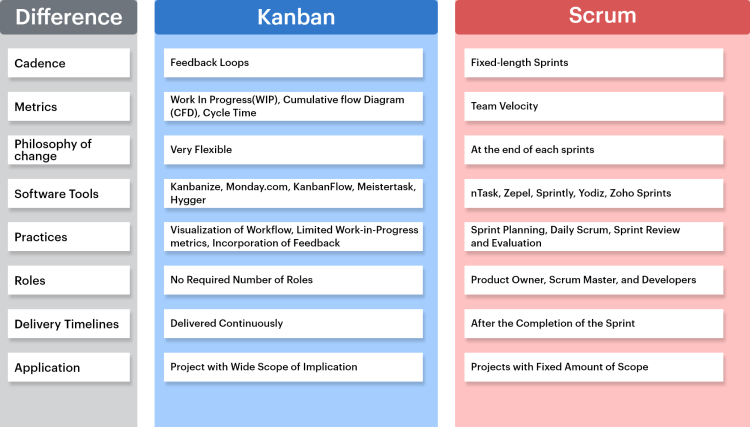
Scrum vs Kanban: Resemblances and Differences
![]() Taru M.
Taru M.
Published: 28 Aug, 2022
Scrum and Kanban both are types of agile methodologies. The agile process was brought into being in the early 2000s by exasperated 17 software developers who wanted to speed up the software development process. They realized that the traditional Waterfall method was lethargic and extensive. It did not yield the desired result for the users.
One of the main reasons behind this is the rapidly changing market dynamics which subsequently impact people’s choices and preferences. The Waterfall method did not allow the developers to incorporate these dynamics because of its extensive development cycle (which lasted for over a year).
Introduction of agile practices to the developing personnel enabled them to develop software rapidly, efficiently, and iteratively by incorporating users’ feedback.
Developers and project managers in committed web or mobile app development company adopts different methodologies of agile for their goals and team orientation. Among these, Kanban and Scrum are pretty similar yet different.
So what are these differences? Let’s unravel them!
What is Scrum?

Scum is an incremental approach. In Scrum processes, the project is divided into smaller incremental blocks of tasks called sprints. Each of these sprints must be completed within a set time frame—which could range from a week to a month, depending on the goals of the scrum team.
Each of these sprints has different stages: Planning, Building Minimum Viable Product, Testing, and Reviewing. This cycle is repeated several times. This way, the scrum team has several different versions or incremental releases of the same product.
With each sprint, the quality and usability of the product are enhanced because the feedback received at the end of each iteration is incorporated into the next.
The Scrum Team
An average Scrum team consists of three to nine members—although there is no fixed, definite number. The size of the scrum team depends on various factors such as the organizational structure, project scope, project budget, etc.
Stating that there are three roles that are essential in a successful scrum team:
- Product Owner: The Product Owner is the head of the entire Scrum Team. They are responsible for planning, monitoring, and ensuring that each sprint reaches a fruitful conclusion.They are also responsible for engaging and communicating with the stakeholders on regular bases and updating the team about the same.
- Scrum Master: They are the leaders of the team of developers. They act as a link between the Developers and Product Owners.
In essence, Scrum Masters are the subordinates of the Product Owners.They are responsible for dividing the project in multiple increments and iterations, organizing the developers, assigning tasks, and managing the project backlog. - Developers: They are responsible for the execution of the iterations. They are the one’s who implement and make changes in each iteration based on the users’ feedback.
The Scrum Process
The Scrum Process entails of a series of meetings that are also called Scrum Ceremonies. They are essential to ensure successful completion of Daily Scrums, sprint planning, iteration reviews, and refining Scrum backlog.
- Sprint Planning: Before the developers start working on the Sprint, the Product Owner, Scrum Master, and Developers define their priorities as per the Product Backlog (which is basically the to-do list, which illustrates all the tasks for the successful completion of the software development process).
Based on this Product Backlog, they prepare a Sprint Backlog stating the time frame and scope of iterations to be completed in a specific Sprint. - Daily Scrums: These quick 15 minutes meetings are conducted every day, where the team members briefly discuss the tasks they completed the previous day and state the tasks they wish to consummate that day. These daily meetings ensure transparency and accountability among the team members.
- Iteration Reviews: These meetings are conducted at the end of each sprint. These meetings allow the developing team to share their working progress and visualize how far they have come in the developing process.
- Evaluation: At this step, the Scrum team evaluates and acknowledges users’ experiences. They reflect on this feedback and set the tone for the upcoming Sprints.
- Refining Product Backlog: After reviewing and evaluating the completed Sprint, the team revisits the Product Backlog to refine it. Based on the progress, they add more details, make adjustments and redefine priorities for the upcoming Sprints.
What is Kanban?

The guiding principle of the Kanban approach is the visualization representation of the workflow on a board called the Kanban Board. In this approach, the software development team lays the fundamental groundwork for all the tasks in a visual set-up. This way all the team members are able to see the number of tasks and prioritize their workflow and pace accordingly on the Kanban Board. In Kanban, all the members are equally responsible.
The Kanban Team
Although there are no designated roles in a Kanban team. Since the process is highly vigorous in nature the priorities keep on shifting and might also require adding or removing team members based on the progress of the project cycle. In short, in the Kanban approach, the team members have to be extremely adaptable.
Despite there are the certain specified role that forms a Kanban Team, note that these roles might differ from team to team, the scope of the project, and software development.
- Service Delivery Manager or Flow Master: A flow master is responsible for maintaining a streamlined workflow that is efficient for complex projects. They hold regular meetings, monitor the Kanban Board, and ensure transparent communication with and among the team members so that everybody is on the same page.
They also ensure that the resources are not wasted and are put to the best of their use for maximum customer satisfaction. - Service Request Manager: Their job role entails understanding the needs and expectations of the customers. They also act as risk managers and facilitate the prioritization of tasks.
Scrum vs Kanban: Key Differences

Both Scrum and Kanban frameworks have their own set of values and render useful ways to keep track of the software development process and project management. Let’s explore the differences:
- Cadence: It refers to the rhythm or sequential flow with which the software development teams work.In the Kanban approach, the flow of work is carried out in feedback loops.Whereas in Scrum, the flow of work is carried out in fixed-length sprints
- Metrics: Since the workflow is constant in Kanban Workflow, ‘Work in Progress’ is an important metrics which prevents the team from lining up too many projects. ‘Cumulative Flow Diagram’ (CFD) helps the team to visualize the workflow and keep track of each item. Another metric is the measurement of the ‘cycle time’ and the amount of time taken to complete on full cycle.Whereas in the Scrum framework, to analyse their growth, teams use metrics such as sprint goals, team velocity, team capacity, and type of work.
- Philosophy of change: It refers to the ways and techniques a team undertakes to implement the changes and modifications based on the users’ feedback. Software development teams may sometimes also require to change their entire course of action.In Kanban, the implementation of changes and modifications is very flexible for the entire team because of the continuous flow of progress. Depending on the feedback and users’ requirements, it is easier to revamp the project process.In Scrum, To implement changes Scrum teams have to discuss the desired changes at the end of each sprints and also figure out how to limit the requirements of changes for future iterations as well to ensure maximum consumer satisfaction. If the team often changes its course of action, it reflects the inefficiency of the team.
- Software Tools: For both, Scrum and Kanban, there are a lot of tools that allow them to manage, reflect and track their functions. These tools also help them to spot any problems and find a solution quickly.For Kanban, Kanbanize, Monday.com, KanbanFlow, MeisterTask, Hygger are some of the popular tools.There are many software tools available for Scrum as well. These help in product backlog management, time management, etc. Some of the popular Scrum software tools are: nTask, Zepel, Sprintly, Yodiz, and Zoho Sprints.
- Practices: There are certain set of practices that determine the functionings of the software development teams.For Kanban, these set of practices are visualization of workflow, limited work-in-progress metrics, and incorporation of feedback.Sprint planning, daily scrum, sprint review and evaluation are the certain set of practices essential for Scrum.
- Roles: As discussed above, both agile frameworks consists of certain performatory roles and practices.Although their are no required number of roles in Kanban, Service Delivery Manager or Flow Master and Service Request Manager are the two roles a software development team following Kanban approach can have.In Scrum, there are Product owner, scrum master, and developers.
- Delivery Timelines: In Kanban approach the digital products are delivered continuously based on the set due dates by the business.Whereas, since Scrum is an incremental approach the products are delivered after the completion of each sprint.
- Application: Even though both are agile methodologies, their application may depend on the project and the type of goals a software development team wants to achieve.Kanban suits the project which have a wide scope of implication. Whereas Scrum is suitable for teams with a fixed amount of scope.
Copyright © 2023 NetMaxims Technologies Pvt. Ltd.
All Rights Reserved














